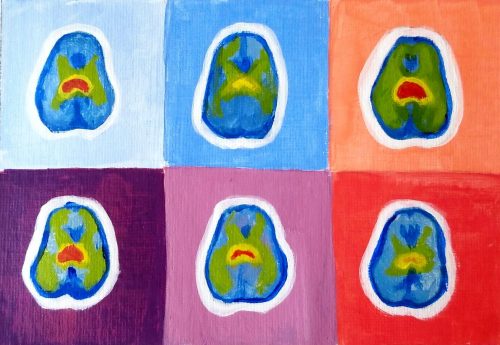Art courtesy of Charlotte Leakey.
When Kelly Cosgrove was a graduate student in clinical psychology, she started out her research in behavioral neuroscience, with a focus on human addictive disorders. But in the course of her studies, she became intrigued by the association between the brain and behavior. This newfound fascination led to a transition into studying Positron Emission Tomography, or PET, brain imaging in neuroscience.
PET imaging begins with the injection of a radiotracer –– a chemical compound labelled with a radioactive isotope for easy detection –– into someone. As the radiotracer decays, it emits positrons, subatomic particles that have a positive charge, which collide with electrons and form gamma rays that are detected by a PET camera. Different radiotracers can target specific chemicals or proteins in the brain, giving researchers an understanding of neurobiology at the molecular level. PET differs from other brain imaging techniques in that it can detect quantifiable levels of neurochemicals, whereas other methods, including a few types of magnetic resonance imaging, focus on brain structure, volume, and electrical activity. This enables researchers to track detailed changes in neurochemical activity in real time and can be leveraged to understand how the brain recovers from addiction.
Currently, Cosgrove’s lab investigates a wide range of addiction disorders –– including alcoholism, nicotine addiction, opioid use disorder –– and psychiatric disorders –– such as PTSD and depression, which can often develop simultaneously. Volunteers come in for an intake appointment and are subjected to psychiatric and medical screenings before participating in a PET scan. Different specialists, from physicists to radiochemists, are involved in gathering and analyzing the resulting outcome measures, Cosgrove said. “It’s really team science to do PET imaging in people,” Cosgrove explained.
Some of the team’s most intriguing findings have stemmed from their exploration of biological sex differences. Among these interesting observations is what the group has unearthed about the mechanisms underlying addiction to tobacco smoking. “There are tons of studies showing that if you give animals drugs that they have dopamine release in the ventral striatum, but almost all of these studies were done in male rodents,” said Dr. Cosgrove, “But when we did the study in people, we found that the dopamine release that happens in the ventral striatum in all the preclinical literature in the animals, we did find it in the men who smoked cigarettes but not in the women who smoked cigarettes. And smoking is a good example because they’ve found sex differences in treatment, too, that women don’t respond as well to the nicotine patches.”
The finding highlights the importance of including women in research studies, and female animals in animal studies in order to give the best possible treatment to every patient. “Otherwise, the default is men. You’re treating everybody based on half the population,” said Cosgrove. “It’s actually really critical and important that we not just do sex difference research, but that it becomes normalized. I think why it hasn’t been studied until relatively recently is because there were no women scientists. You learn so much from working with all different kinds of people with different perspectives on things.”
Recently, Cosgrove has been working in neuroimmunology, a field that draws connections between the brain and immune response. Her work has found that people who are psychiatrically compromised have blunted immune responses compared to those who are healthy, which could explain why disorders such as PTSD or addiction are correlated with many medical comorbidities.
“The immune system in general might be a target to help with some of the medical issues, but it might also end up fixing a lot of the psychiatric issues,” explained Dr. Cosgrove. “I think [this] speaks to a holistic, transdisciplinary way of treating people, which is important… Team science is more impactful.”
Moving forward, Cosgrove is involved in establishing the Yale-Specialized Center of Research Excellence (YALE-SCORE), a new research center grant with Dr. Sherry McKee as the principal investigator. The center will investigate sex differences in alcohol use disorder, specializing on understanding sex-specific issues and developing treatments –– a particularly relevant focus because of how the disorder prevalence is increasing among women.
“We’re looking at a marker of microglia in the brain, and then a marker of synaptic density,” said Dr. Cosgrove. “As part of the study, we follow people over time and see how they respond to different medications, whether there’s differences in those PET markers and whether that impacts the recovery from their addiction problems.”
Another project on the horizon includes studying the mechanisms underlying obesity in the context of the immune system. “Tobacco smoking and obesity are really driving the premature death in the world,” emphasized Dr. Cosgrove. “So sometimes it feels like you’re beating a dead horse, but we can’t just get bored and stop studying it.”
References
Davidson, C. Q., Phenix, C. P., Tai, T., Khaper, N., & Lees, S. J. (2018). Searching for novel PET radiotracers: imaging cardiac perfusion, metabolism and inflammation. American Journal of Nuclear Medicine and Molecular Imaging, 200–227.
Gardner, C. (2020, March 13). Yale School of Medicine. Retrieved from Yale Scientists Awarded $8.4M Grant to Develop Treatments for Women With Problem Drinking: https://medicine.yale.edu/news-article/23101/
Cosgrove, K. (2019, September 24). Yale School of Medicine. Retrieved from Cosgrove Lab: https://medicine.yale.edu/lab/cosgrove/
Cosgrove, K. (2020, September 17). (A. J. Loste, Interviewer)

